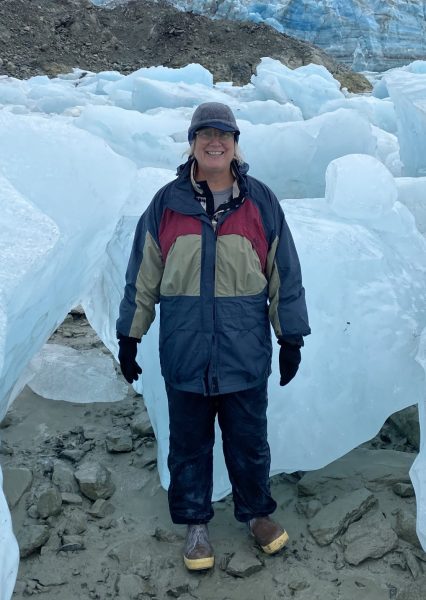Gail Christeson: Former UTIG Associate Director
December 5, 2022
Like many scientists, Gail Christeson often turned to the National Science Foundation for research funding. It’s how she ended up leading one of the longest continuous seismic imaging profiles of the Earth’s oceanic crust, and it’s what took her to the southern Gulf of Mexico to drill an underwater crater that marked the fate of the dinosaurs.
“I understand a lot of what’s going on with the PIs [principal investigators] when they’re proposing a project,” she said. “I’ve been on that side of it, so it makes me better able, I think, to assess them.”
That insight guides her decisions as director at NSF’s marine geology and geophysics program, a role she took late in 2021 after 28 years as a researcher and later as an associate director at the University of Texas Institute for Geophysics (UTIG). Her role involves directing the agency’s money toward impactful studies of the geology of ocean basins.
Before she joined NSF, Christeson’s career focused on the Earth’s oceanic crust. Unlike continents, oceanic crust is transitory and geologically much younger. New crust emerges from mid-ocean ridges and heads landward, where subduction shunts it back into the Earth — its movement is the engine belt of plate tectonics.
Christeson’s interest in it began when she was an honors freshman learning about plate tectonics for the first time at an intro to geophysics course.
From volcanoes to earthquakes, “it just explained everything,” she said. Geophysics was followed by a course in oceanography, which led to a joint graduate school program with the Massachusetts Institute of Technology and Woods Hole Oceanographic Institution, funded by an NSF graduate fellowship. That began with back-to-back scientific cruises in the mid-Atlantic Ocean.
“I found I really liked that environment. I liked acquiring data for the first time, and I liked the team aspect of collaborating with other people,” she said.
Her doctoral research focused on the characteristics of brittle rock layers in younger crust, near where it comes out of the Earth, and relied largely on seismic imaging acquired using the novel method of detonating small explosives on the seafloor and recording the Earth’s echo with ocean bottom seismometers. That research landed her a job at UTIG in 1994, where she was soon back at sea but at the other end of the tectonic conveyor, studying Costa Rica’s subduction zone.
Her first turn at the helm of a research expedition came in 2003 as chief scientist aboard the R/V Maurice Ewing on a mission to Hess Deep in the Pacific Ocean, where a massive seafloor rift splits the Earth like a road cut. The research matched subsurface images of oceanic crust with the exposed rock layers, giving scientists a Rosetta stone to interpret the geology of the oceans.
Since Hess Deep, Christeson has been chief or co-chief scientist on six major investigations of oceanic crust, including a large project in the southeast Caribbean involving two ships and land-based science teams, and a similar coordinated study of fault zones in the Gulf of Alaska with UTIG colleague Sean Gulick. Christeson and Gulick also collaborated on surveys of the underwater Chicxulub crater near the Yucatán Peninsula, in preparation for a major 2016 expedition (led by Gulick) to drill into the crater’s peak ring.
Collaboration is the connecting thread between Christeson’s research projects and is, she said, what appealed to her about being a researcher.
“Gail is very uncomplicated,” said Dominik Kardell, a former student of hers. Working with Christeson, according to Kardell, was an education in efficiency and pragmatism, a style she applied to everything from research to teaching — including a Python for Geosciences course she launched in 2019, for which she won a departmental Knebel Teaching Award in 2020.
“She taught what people really needed to use,” Kardell said. “Once the rumor spread, [her Python course] became very popular. Everyone wanted to take it.”
The idea to teach the programming language Python to geoscientists began in 2018 when Christeson noticed its potential for making data analysis more accessible. She taught herself Python, put a syllabus together and proposed a new class for geoscience students.
“She was amazing, just such an incredibly effective instructor,” said Sharon Mosher, the Jackson School’s dean from 2009 to 2020. “The pedagogy she was using — learning by doing — was exactly the kind that really makes a difference in terms of students actually learning. It was all best practices.”
In 2017, Christeson was appointed associate director of UTIG and was soon involved in the institute’s search for a new director. What struck Mosher about Christeson during the two-year transition was the concern she showed for the welfare of UTIG’s staff and researchers.
“All three [Jackson School units] had such incredibly different characters, and of all, the institute was always the most relaxed,” she said. “There’s more of a comradery and interest in what each other is doing that I think Gail had a large part to do with.”
According to Mosher, Christeson’s leadership style makes her a natural fit for science administration. But for Christeson, the decision to take the NSF
job was a chance to try something new.
“I’m just excited. Every day, I’m learning new things, and after almost 28 years at UTIG, it’s fun to have a big change,” she said.
Others at UTIG previously recruited by the federal agency include UTIG former director Terry Quinn.
Back to the Newsletter
